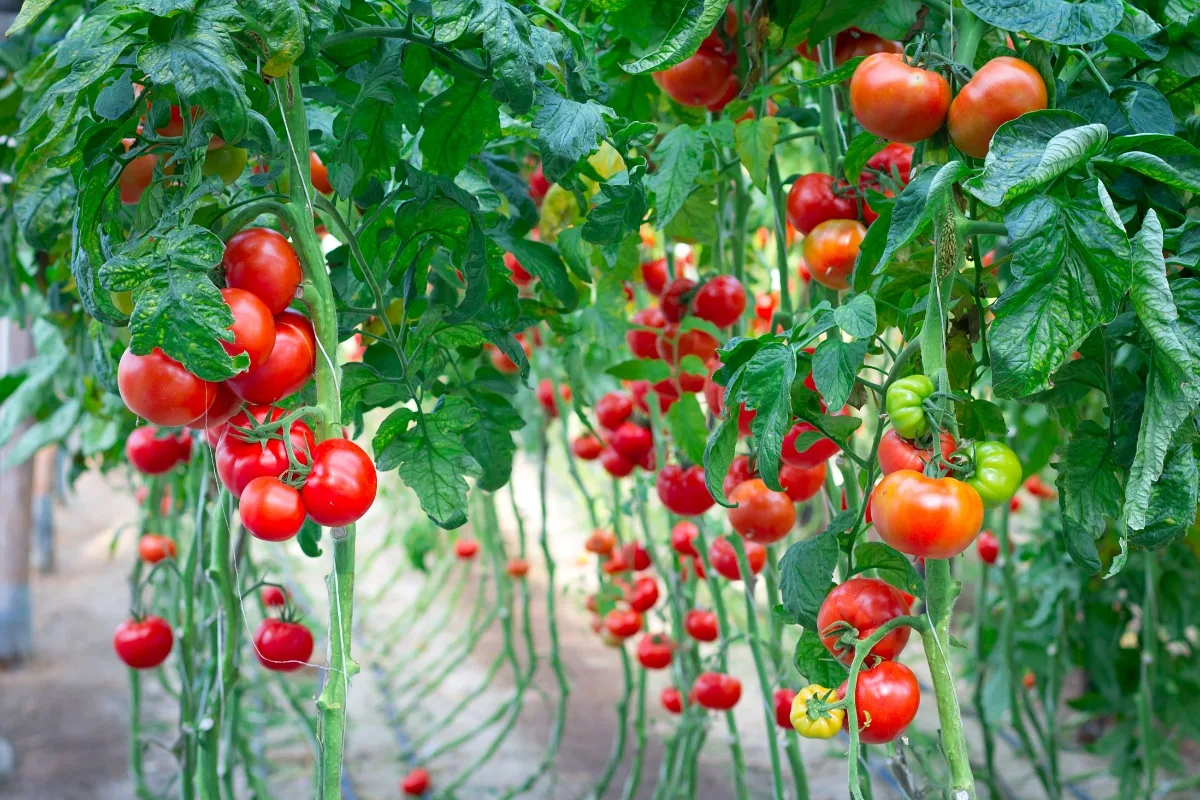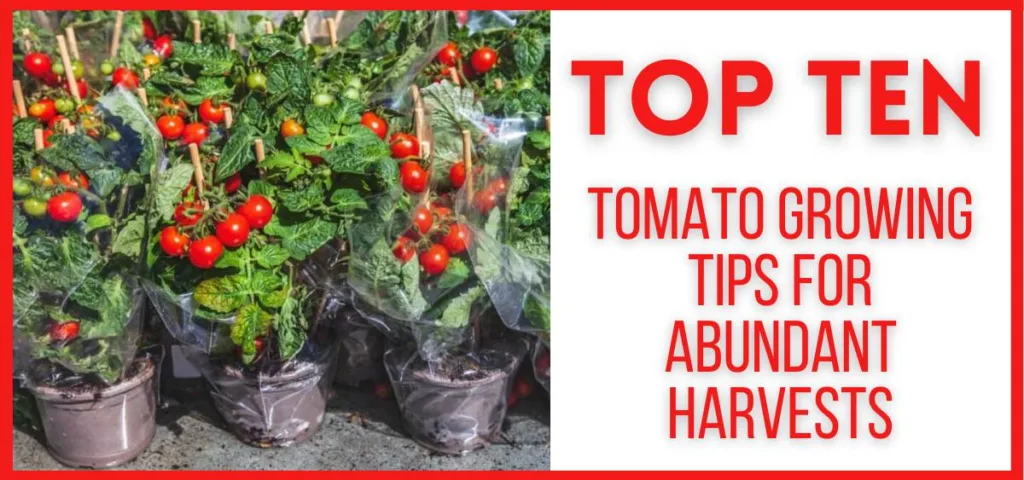Tomato growing tips unlock a world of possibilities for plant enthusiasts, enabling them to nurture not just decorative foliage but also cultivate a bounty of fruits and vegetables within the confines of their homes. The unparalleled flavor of homegrown veggies and fruits surpasses that of store-bought produce, owing to the organic methods employed in their cultivation and the tender care lavished upon them. The beauty lies in the fact that nearly every vegetable can thrive in a home garden. Contrary to popular belief, you don’t need a vast in-ground garden plot to cultivate succulent tomatoes.
With adequate sunlight, even a modest balcony, patio, or deck can serve as the perfect setting for potted tomato plants. While growing tomatoes in containers demand a bit more attention due to limited access to water and nutrients, following a few essential tomato growing tips ensures a bountiful harvest of sun-ripened fruit. By providing your potted tomato plants with the extra care they need, you’ll be rewarded with an abundance of juicy tomatoes to savor and share with loved ones.
Also, read: Top 10 Front-Yard Decor Ideas for a Welcoming Entrance
Tomatotopia: Top 10 Tomato Growing Tips for Abundant Harvests
Welcome to the ultimate guide to tomato growing tips for abundant harvests! Whether you’re a seasoned gardener or a novice enthusiast, cultivating juicy tomatoes is a rewarding experience. In this comprehensive guide, we’ll explore the top techniques and strategies to ensure your tomato plants thrive and yield bountiful harvests.

1. Pick A sunny Location
Tomatoes are sun-loving plants that require full sunlight to thrive and produce a bountiful harvest. Position your tomato plants in a location that receives at least six to eight hours of direct sunlight per day, preferably in the morning and early afternoon when sunlight is most intense.
Adequate sun exposure promotes photosynthesis, which is essential for carbohydrate production and fruit ripening. Ensure proper spacing between plants to prevent overcrowding and competition for sunlight, allowing each plant to receive ample light for optimal growth and development.
2. Pick the Perfect Plant
Not all tomatoes are created equal! Selecting the right variety is key to a successful and fruitful harvest. Start by considering your garden space. Do you have sprawling fields or cozy containers? Determinate tomatoes, growing to a set height and producing all their fruits at once, are ideal for smaller spaces. Indeterminate vines, perfect for staking or trellises, will sprawl and produce fruit throughout the season.
Think about how you’ll use your bounty. Cherry tomatoes are perfect for snacking, while larger varieties are great for salads, sauces, or slicing. Don’t forget about flavor and disease resistance! Research heirloom varieties for unique tastes, or choose hybrids known for their resilience. By understanding your needs and the tomato’s personality, you can select the perfect plant for a harvest that’s both delicious and rewarding.
Also, read: Top 10 Beginner Gardening Tips for Success in 2024
3. Start with Strong Seedlings
The key to a bountiful tomato harvest starts long before you sink your first seedling into the soil. Choosing healthy, vigorous seedlings lays the groundwork for a successful season. Whether you’re a seed-starting savant or prefer the convenience of transplants, prioritize quality. Look for sturdy, deep green stems that haven’t been stretched.
Avoid plants with yellowing leaves, signs of pests, or evidence of disease. For transplants, select those with a well-developed root ball that fills the pot but isn’t rootbound. By starting with strong seedlings, you’re giving your tomato plants the best chance to thrive and rewarding you with a harvest of delicious, homegrown tomatoes.
4. Plant ’em Deep
When it comes to transplanting your tomato seedlings, forget the shallow approach! Buried treasure may not be real, but burying the stem of your tomato plant a bit deeper than it was in the pot is a secret weapon for successful harvests. This technique, known as deep planting, encourages the development of a strong, extensive root system.
These extra roots act like tiny sponges, soaking up more water and nutrients from the soil, leading to a healthier, more resilient plant. Think of it as giving your tomato a built-in irrigation system and buffet table, all in one. The deeper roots also provide better stability, especially for indeterminate varieties that tend to grow tall and viney. So, don’t be afraid to get a little dirty and dig a deeper hole for your tomato transplants. Your plants will thank you with a bounty of delicious fruit!
Also, read: Top 10 Budget-Friendly Backyard Decor Ideas in 2024
5. Give Them Room to Breathe
Tomatoes may be social creatures, but they don’t appreciate cramped quarters. Spacing your tomato plants properly is crucial for maximizing their health and harvest. Crowded plants struggle for air circulation, which can lead to a domino effect of problems. Poor airflow creates a breeding ground for disease, hinders the vital process of photosynthesis, and weakens the stems, making them more susceptible to breaking.
When planting, adhere to the recommended spacing for your specific tomato variety. Determinate tomatoes, known for their compact growth, typically need 18–24 inches between plants. Indeterminate vining varieties are more expansive and require 36 inches or more for optimal air circulation and fruit production. Remember, proper spacing allows each plant to thrive, leading to a flourishing garden and a basket overflowing with juicy, homegrown tomatoes.
6. Stakes are Your Friends
Indeterminate tomato plants, the champions of long harvests, are vigorous vining climbers. While their sprawling nature can seem manageable early on, as they mature and become laden with juicy fruits, support becomes crucial. Stakes aren’t just there to prevent them from toppling over; they offer a multitude of benefits. Sturdy stakes encourage proper plant growth, allowing them to climb upwards instead of sprawling on the ground.
This improves air circulation, reducing the risk of disease. Additionally, staking keeps developing fruits off the soil, preventing blemishes and rot. Tomatoes ripen more evenly with better sun exposure, thanks to proper support. Finally, staking makes harvesting a breeze—no more digging through tangled vines to reach those delicious tomatoes! So, embrace the stake—it’s your secret weapon for a happy, productive tomato plant.
Also, read: Top 10 Tips for Building Healthy Relationships
7. The Power of Pruning
Pruning your tomato plants might seem counterintuitive, but it’s a powerful technique for maximizing your harvest. By strategically removing suckers, those small shoots that sprout between the stem and branches, you’re directing the plant’s energy toward fruit production. This not only encourages the development of larger, juicier tomatoes but also improves air circulation around the plant, reducing the risk of disease.
For indeterminate varieties, regular pruning also helps maintain a manageable size and allows for better light penetration, ensuring all your tomatoes get a chance to ripen beautifully under the sun. So, don’t be afraid to snip! With a little focused pruning, you’ll be surprised at the bounty your tomato plants can produce.
8. Water Wisely
When it comes to watering your tomatoes, consistency is key! They crave consistent moisture but avoid drowning them with constant showers. Aim for deep watering at the base of the plant, allowing the soil to dry slightly between waterings. This encourages the roots to grow deep, searching for moisture, making your plants more resilient. Avoid overhead watering, as this can promote fungal diseases on the leaves.
Early morning watering is ideal, allowing the sun to dry any moisture on the leaves throughout the day. If you’re unsure about moisture levels, stick your finger a few inches into the soil. If it feels dry, it’s time to water! By following these simple tips, you can provide your tomatoes with the perfect balance of hydration, ensuring a bountiful harvest of juicy, delicious tomatoes.
Also, read: Top 10 Most Spoken Languages in the World
9. Feed Your Plants
Tomatoes are hungry growers, and to produce an abundant harvest, they need a steady supply of nutrients. Don’t underestimate the power of fertilizer! Choose a balanced fertilizer formulated specifically for tomatoes, which will provide essential nutrients like phosphorus for strong fruit development and potassium for overall plant health. When and how much to feed depends on your chosen fertilizer, so always follow the application instructions carefully.
Generally, you’ll want to start feeding your plants a few weeks after transplanting and continue throughout the growing season, stopping a few weeks before your final expected harvest. By providing your tomatoes with the right food, you’re not just giving them a boost, you’re investing in a future filled with juicy, homegrown bounty!
10. Mulch Matters
A layer of organic mulch, like straw or shredded leaves, spread around the base of your plants is a game-changer. Firstly, it acts like a tiny moisture shield, helping retain precious water in the soil so you can water less frequently. This is especially beneficial during hot, dry spells. Secondly, mulch creates a barrier between the soil and the sun, keeping the roots cool and preventing the soil from baking in the summer heat.
On the plus side, mulch suppresses weeds that compete with your tomatoes for water and nutrients. As an added perk, over time, organic mulch breaks down, enriching your soil and improving its overall health. So, for happier, healthier tomato plants and less work for you, mulching is a must-do!
Also, read: Top 10 Healthy Cooking Hacks for Busy Weeknights in 2024
FAQs on Tomato Growing Tips
Q: Can I grow tomatoes from store-bought tomatoes?
While technically possible, it’s not recommended. Store-bought tomatoes are often bred for appearance and disease resistance, not for seed-saving. Their seeds may not produce reliable results.
Q: What’s the secret to preventing blossom end rot?
Blossom-end rot is a common calcium deficiency. Ensure even watering and consider using a fertilizer formulated for tomatoes, which often contains extra calcium.
Also, read: Top 10 Must Read Books for the Literary American in 2024
Q. What is the best fertilizer for tomatoes?
Choose a balanced fertilizer with an N-P-K ratio of 10-10-10 or similar, and apply according to package instructions.
Q: Is it better to start tomatoes from seeds or seedlings?
This depends on your climate and gardening experience. Seeds offer more variety but require more care. Seedlings are a good option for beginners or those with shorter growing seasons.
Q: How do I ripen green tomatoes after I’ve picked them?
Place them in a paper bag on your countertop, out of direct sunlight. They will continue to ripen as long as they are already starting to turn color when picked.
Conclusion: The Final Thought
As we conclude this exploration of tomato growing tips, it’s important to reiterate the key factors that contribute to abundant harvests. Consistent watering, optimal sunlight exposure, and well-draining soil are essential for healthy tomato plants. Fertilizing regularly with a balanced fertilizer provides the necessary nutrients for growth and fruit production. Pruning and staking support the plants, preventing damage and promoting air circulation. Careful pest and disease management is crucial to protect your tomato plants from harm. By following these tomato growing tips, you can cultivate thriving tomato plants and enjoy a bountiful harvest of delicious, homegrown tomatoes. Remember, with a little patience and care, you can reap the rewards of your gardening efforts. Happy growing!
Also, read: Top 10 Sustainable Living Hacks for Eco-Conscious Americans


































